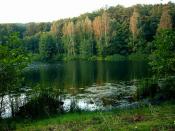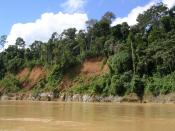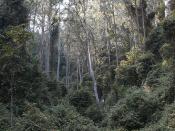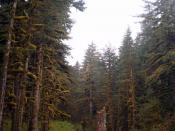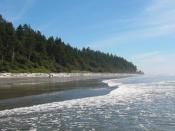Chris Diekhans Professor Ianovichi English Tropical rain forests cover only six percent of the Earth's land, but they contain over half of the plant and animal species on Earth. With the continuation of destroying the rain forest, we are losing many things that are vital to our survival. The rain forests give us about 25% of today's medicines and a huge amount of our oxygen supply. Environmentalists fear that in another thirty years there may be no tropical forests! Everyone is affected by the loss of the rain forest. Ingredients for deodorant, medicines, chocolate, and coffee come directly from the rain forest. Medications that are necessary for people that have leukemia and Hodgkin's disease need the rain forests because the drug that they take comes from a rosy periwinkle, which is found only in the rain forest. In fact, 70% of the plants identified as having anti-cancer properties live in tropical rain forests.
Because the rain forests consume carbon dioxide through photosynthesis, they counteract much of the carbon dioxide that is pumped into the environment, which is the prime cause of the greenhouse effect. Without these forests to slow global warming, half of our country would be under water. Because rain forests also store carbon, when these rain forests are burned in the clearing process, large amount of carbon are released into the atmosphere. This too accelerates the greenhouse effect. The loss of the tropical forests affects short-term global weather conditions as well. The absence of huge areas of tree coverage causes more sunlight to be reflected off the earth's surface, disrupting wind currents and rainfall patterns. Also, as the rain forests' sponge effect (their ability to absorb and re-circulate rainfall) is lost, floods and droughts cause soil erosion as the land is turned into a desert.
The death of a rain forest begins with a single road cut though the forest to permit logging. To harvest one valuable type of tree, loggers may destroy 17 other species of trees. The farmers come next to torch what is left so that they are able to plant crops like corn and sugarcane. After a few years the soil is no good for farming and may be used to graze cattle. Soon after, all grass is gone and the soil begins to erode from heavy rains. All of the topsoil will be washed away and what was once a beautiful forest is now a wasteland.
In the past thirty years we have destroyed more than 40 percent of the earth's rain forests. When we cut down rain forests we are killing thousands of animals, insects, plants, and animals. In four square miles of rain forest there may be 1,500 species of flowering plants, 750 species of trees, 125 mammals, 400 birds, 100 reptiles, and 60 amphibians. A recent study showed that we are cutting down fifty to one hundred acres of rain forest each minute. The area of a football field is destroyed every second of every day.
Rain Forest Destruction Miller, G. Tyler Jr. Living in the Environment. Belmont: Wadsworth Publishing Company, 1987.
Steger, Will and Bowermaster, Jon. Saving the Earth. New York: Bryon Preiss, 1990.
